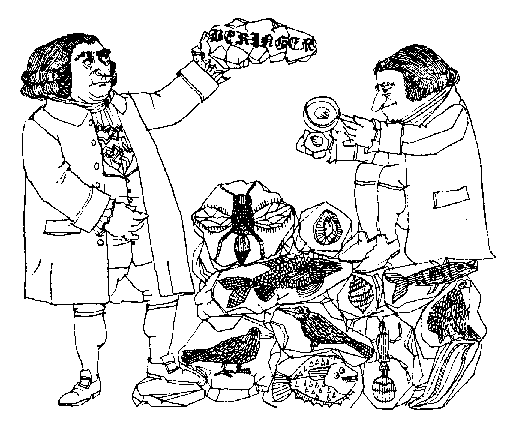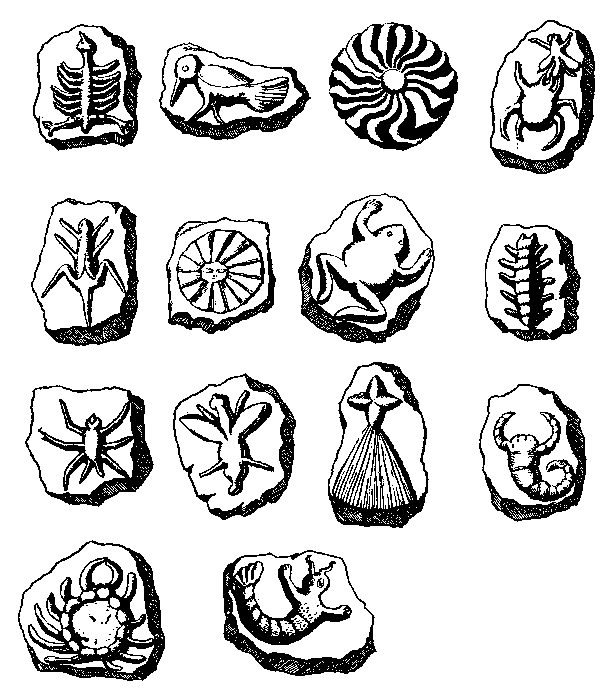BERINGER'S AUTOGRAPHED STONES
by Donald E. Simanek
In the early 18th century competing theories arose about the nature of fossils. Some thought they were the bones of dead creatures buried in floods, then turned to stone in relatively recent (historic) times. Perhaps they had died in the Genesis flood. Others thought fossils were simply rocks that happened to mimic animal shapes. But some fossils clearly did not resemble any animals still living. Those were thought to be oddities, pranks, or sports of nature (lusi naturae). Perhaps God had chosen to fashion some stones to look like fish skeletons. Who are we to question His reasons for doing so? This was a period of history when even the best scientists mixed science and religion, producing a muddled mess. (For more historical background, see Chapter V of White.)

Dr. Hohann Bartholemew Adam Beringer of the faculty of medicine of Würtzburg, thought that some few of these stones might be dead animals (fossils), but most were just handiworks of God, fashioned for His own pleasure. Beringer lectured widely on this theme and was highly respected in certain quarters.
But he made enemies. Some thought him arrogant and dogmatic in his views. Two of his detractors conceived a scheme to show him up as a fool.
We don't know all of the details of this affair (and we don't even have pictures of the participants), but historical research has revealed who the hoaxers were. J. Ignatz Roderick (Roderique) was professor of geography, algebra, and analysis at the U. of Würtzburg. The other was Honorable Georg von Eckart (Eccard), Privy Councillor and Librarian to the Court and to the University.
Beringer dug up his stones on a particular hill. He hired young men to do the digging. Roderick and Eckart made some special stones and bribed one of the diggers to plant these in the diggings. When these were discovered, Beringer was elated, for they were far clearer than anything previously discovered. He considered them to be the artistic handiwork of God. At great expense he published a book about them, with elaborate plates of the stones.

[The stones still exist, now on display in a museum.
Beringer eloquently defended his interpretation of the stones:
God, the Founder of Nature, would fill our minds with His praises and perfections radiating from these wondrous effects, so that, when forgetful men grow silent, these mute stones might speak with the eloquence of their figures.The more stones he dug up, the more fakes Roderick and Eckart made to seed Beringer's diggings. They even grew more inventive, perhaps hoping that Beringer would catch on. One stone showed the sun and its rays. Another showed stars and comets. And finally, some turned up with Latin, Arabic, and Hebrew characters. Beringer had them translated by scholars. The words gave the name of God, Jehovah! Beringer was elated. Here was proof: God signing his own handiwork.
Even before publication of Beringer's book, critics had pointed out that some of the stones showed evidence of a sculptor's chisel. Beringer had noticed this too, and said in his book:
...the figures...are so exactly fitted to the dimensions of the stones, that one would swear that they are the work of a very meticulous sculptor...[and they] seem to bear unmistakable indications of the sculptor's knife... One would swear that he discerned in many of them the strokes of a knife gone awry, and superfluous gouges in several directions.Beringer even notices that the top surfaces of the stones were smooth, while the lower surfaces were rough and unfinished. But this evidence of sculpting only convinced him more strongly that the chisel was wielded by the hand of God. God was practicing his skills as a sculptor.
One reason religious ideas persist is that no evidence or fact can disprove them. A clever person can always find arguments, albeit empty arguments, which allow him to rationalize any absurd belief to his own satisfaction.
At one point Roderick and Eckart apparently felt the hoax was getting out of hand. They tried to convince Beringer that the stones were a fraud, without however admitting that they were the hoaxers. Beringer himself relates the incident. He tells of "two men, perhaps best described as a pair of antagonists who tried to discredit the stones." Beringer had permitted one of them to enter his dig, and, he says,
Unbeknownst to me, he proceeded to throw it open to the public...appoint a number of diggers, and in the presence of the townspeople indulging in drink, he mockingly condemned the unearthed stones as false [and suppositions impostures.] A short time later, the other of this pair...carved into some of the more impressionable stones Hebrew characters, the figures of a winged dragon, a mouse, a lion, a pomegranate, etc."Beringer then appeals to the reader to see that this was just a plot to discredit his work. Quoting Beringer again:
[They want] to bring down to the dust all my sacrifices, and labors, my very reputation...But Beringer says that this crude trick of planting fakes in no way discredited the other, authentic stones.
There is a story that they even planted a stone with Beringer's own name, but that is probably a fable.
Beringer brought Eckert and Roderick to court, to "save his honor." Some of the court transcript still exists, and in the testimony the hoaxers make clear that they did indeed want to discredit Beringer, because, they said, "he was so arrogant and despised us all."
When Beringer realized he had been hoaxed he spent a huge fortune trying to buy up all copies of his expensive book. He died in 1740, not quite achieving that goal. Fortunately he wasn't around when in 1767 his publisher brought out a second edition to meet demand from the curious, and those who wanted it as a humorous example of misguided faith. This edition outsold the first edition by several thousand copies. (Saunders, p. 50.)
The scandal not only discredited Beringer, it ruined the reputations of Eckart and Roderick. Roderick had to leave Wurzburg. Eckart lost his post and privileges to use the library and archives. This hampered his own historical researches, which were left unfinished at his death.
References
The Museum of Hoaxes has a good page about the Beringer affair.Beringer, Johann. The Lying Stones of Dr. Johann Bartholemew Adam Beringer, Being his Lithographiae Wirceburgensis. Translated and annotated by Melvin E. Jahn and Daniel J. Woolf. University of California Press, 1963. The drawings of the stones reproduced above are from this source. This source also has black and white photos of the stones.
Silverberg, Robert. Scientists & Scoundrels, A Book of Hoaxes. Crowell, 1965. The cartoon above, by Jerome Snyder, is from this source.
White, Andrew Dickson. A History of the Warfare of Science With Theology in Christendom. First published in 1896. Chapter V.
Saunders, Richard. The World's Greatest Hoaxes Playboy Press, 1980.
